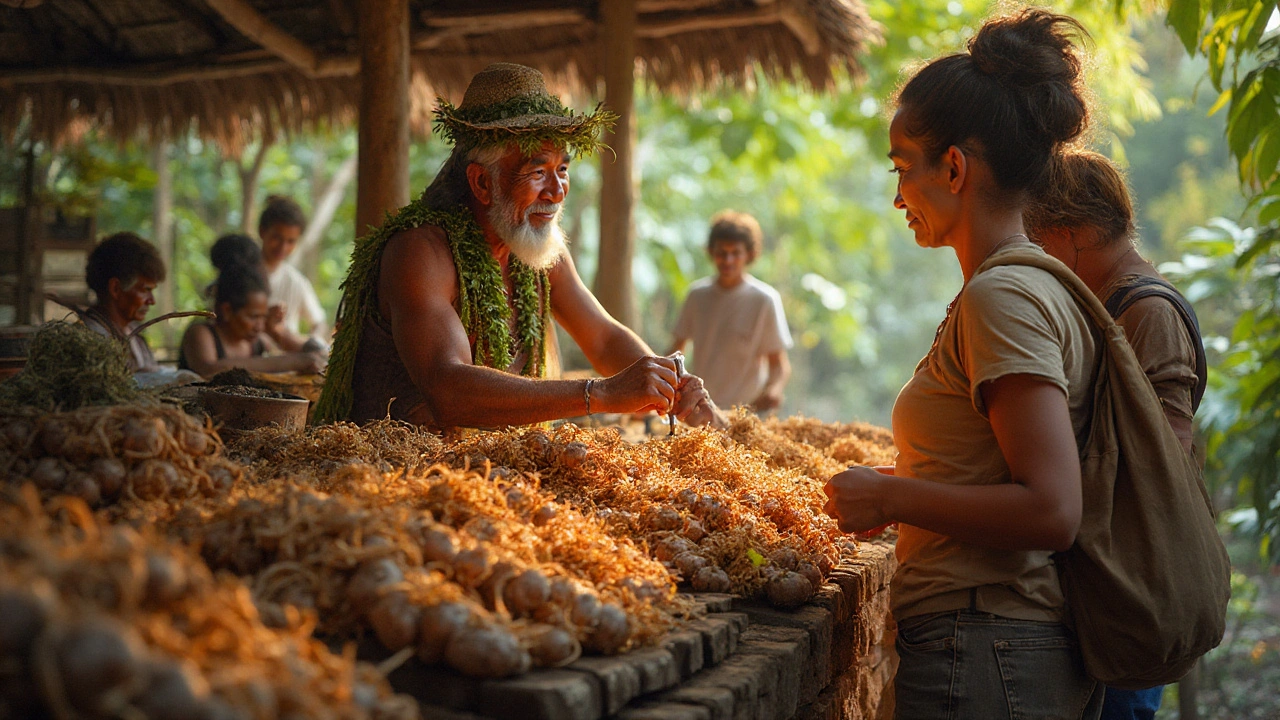Kava is a root‑derived beverage from the Pacific islands that induces relaxation, sociability, and mild euphoria. Originating from Fiji, Vanuatu, Tonga and Samoa, the plant (Piper methysticum) has been used for centuries in ceremonial and medicinal contexts.
Key Takeaways
- Choose noble‑grade kava for a smooth, mellow experience.
- Traditional preparation uses a mortar, pestle, and a tanoa bowl, while instant powder offers speed.
- One serving (30‑50ml) delivers 70‑120mg of kavalactones, the active compounds.
- Stay within recommended limits to avoid liver‑related risks.
- Respect the kava ceremony: cleanse, share, and sip slowly.
Choosing the Right Kava
Not all kava is created equal. The market distinguishes two primary categories:
| Attribute | Noble Kava | Tudei (Wild) Kava |
|---|---|---|
| Kavalactone Profile | Balanced, high‑kavain, low‑dihydrokavain | High‑dihydrokavain, erratic ratios |
| Effect | Calm, sociable, mild euphoria | Intense sedation, possible nausea |
| Safety | Low liver‑risk when used responsibly | Higher hepatotoxic potential |
| Traditional Use | Preferred in ceremonies across Vanuatu and Fiji | Historically used for medicinal ‘quick‑fix’ |
When in doubt, look for noble‑grade labels on reputable vendors. These varieties are cultivated, harvested, and dried under strict standards that preserve the optimal kavalactone balance.
Other factors to consider:
- Origin: Vanuatu’s ‘Nambawan’ and Fiji’s ‘Mara’ are renowned for smooth profiles.
- Freshness: Whole root pieces retain potency longer than pre‑ground powder.
- Moisture content: Aim for 12‑14% - too dry reduces extraction, too moist invites mold.
Preparing Kava: From Tradition to Instant
Two main preparation paths dominate today: the hands‑on traditional method and the convenience‑focused instant powder.
Traditional Preparation
The ritual begins with a tanoa, a large wooden bowl (often carved from breadfruit), used to mix the root with water. The process follows a simple yet precise sequence:
- Grind the dried root pieces using a pestle and mortar until a fine, gritty texture appears. In many Pacific islands, a stone or coconut husk grinder is the tool of choice.
- Fold the ground material into the tanoa, adding cool, filtered water at a ratio of roughly 1kg root to 3L water.
- Knead the mixture for 5‑10minutes, allowing the kavalactones to leach into the liquid. The brew will turn an earthy, opaque brown.
- Strain through a fine‑woven sack (often made of pandanus or nylon) into serving cups.
Key attributes of this method: it extracts the full spectrum of kavalactones, preserves aromatic compounds, and honours the communal spirit of the kava ceremony.
Modern Instant Powder
For busy urban dwellers, instant kava powder offers a ready‑to‑mix solution. The powder is pre‑extracted and dried, so a simple shake‑and‑stir does the trick.
- Measure 1‑2tablespoons per serving (adjust based on potency claims).
- Add 200‑250ml of cold water or coconut milk.
- Shake vigorously for 30seconds; let settle for 2‑3minutes.
- Enjoy the milky brew straight from a glass.
Instant mixes typically contain 80‑110mg of kavalactones per tablespoon, matching the traditional window. They trade the ritual for speed, but they still deliver the calming effect when sourced from noble‑grade farms.
The Kava Ceremony: Etiquette and Experience
The ceremony is more than a drink; it’s a social contract. In Vanuatu, the sequence is called "kava circle" and includes several symbolic steps:
- Opening chant - a short song that invites respect.
- Presentation - the tanoa is placed at the centre; participants sit in a clockwise circle.
- Serving - the eldest or most honoured guest receives the first cup.
- Sip and pass - each person takes a small sip (15‑20ml), places the cup back, and passes it to the right.
- Closing - after the last round, a final chant thanks the plant spirits.
Key etiquette points:
- Never gulp; the ritual values slow, mindful consumption.
- Avoid mixing alcohol or stimulants in the same session.
- Respect any cultural variations - some islands add a pinch of salt or lime.
Even if you’re not in a traditional setting, mirroring these steps can deepen the experience and connect you to the plant’s heritage.

Enjoying the Effects: What to Expect
The primary kavalactones are six lactone compounds (kavain, dihydrokavain, yangonin, methysticin, dihydromethysticin, desmethoxyyangonin) that act on the GABA system. A typical dose provides:
- Onset: 5‑15minutes after sipping.
- Peak: 30‑45minutes - a gentle wave of calm, reduced anxiety, and slight tingling on the lips.
- Duration: 2‑3hours, with a gradual fade.
Because the effect curve is shallow, it’s ideal for wind‑down after work, meditation, or social gatherings where conversation stays mellow.
Dosage tip: beginners should start with 30ml (one small cup) and wait 30minutes before deciding to have more. This prevents over‑sedation and lets you gauge personal sensitivity.
Safety, Regulations, and Responsible Use
While kava is generally safe for most adults, a handful of concerns have shaped modern regulations.
- Liver health: Early 2000s reports linked some commercial extracts to hepatotoxicity. Subsequent research points to poor‑quality, non‑noble varieties and ethanol‑based extraction as culprits.
- Regulatory bodies: The Therapeutic Goods Administration (TGA) of Australia classifies kava as a ‘restricted drug’ - it can be sold in low‑strength forms with clear labelling.
- FDA stance: In the USA, kava is available as a dietary supplement but carries a warning label regarding liver risk.
Best practices to minimise risk:
- Stick to noble‑grade, water‑based preparations.
- Avoid chronic daily use - give your liver a break every 2‑3 weeks.
- Don’t combine with alcohol, acetaminophen, or other hepatotoxic agents.
- Consult a healthcare professional if you have pre‑existing liver conditions or are pregnant.
Flavor Boosters and Pairings
Kava’s earthy taste can be an acquired love. Here are three common pairing ideas that stay true to the tradition:
- Coconut water - adds a subtle sweetness and matches Pacific island roots.
- Honey and lime - a squeeze of lime brightens the brew; a drizzle of honey smooths the bitterness.
- Vanilla‑infused water - a splash of natural vanilla extract creates a soothing aroma without masking the kavalactones.
All additions should be made after straining, ensuring they don’t interfere with the extraction process.
Troubleshooting Common Issues
If your brew turns overly cloudy, tastes excessively bitter, or leaves you feeling drowsy rather than relaxed, try these fixes:
- Cloudy brew: Use cooler water (15‑20°C) and reduce kneading time; excess heat extracts fats that cause cloudiness.
- Bitterness: Add a pinch of sea salt or a teaspoon of raw honey before serving.
- Too strong sedative effect: Cut the root‑to‑water ratio in half or switch to a milder noble variety.
- Residue in cup: Upgrade to a finer strain sack (e.g., cheesecloth) to catch fine particles.
Remember, each batch is a learning curve. Keep a simple log of root type, water temperature, and perceived strength; over time you’ll dial in the perfect recipe.

Frequently Asked Questions
What is the difference between noble and tudei kava?
Noble kava is cultivated for a balanced kavalactone profile that yields calm, sociable effects with low liver risk. Tudei (wild) kava often has higher dihydrokavain levels, leading to stronger sedation and a higher chance of hepatotoxicity, especially when extracted with alcohol.
How much kava should a beginner drink?
Start with a single 30‑ml cup (about one‑third of a standard serving) and wait at least 30 minutes. If the effect feels mild, you can add another cup. Never exceed 120ml in a single session without a break.
Can I mix kava with alcohol?
Mixing kava and alcohol is not recommended. Both depress the central nervous system, which can amplify drowsiness, impair coordination, and increase liver strain.
Is instant kava powder as effective as traditional brew?
When the powder is sourced from noble‑grade roots and processed without harsh solvents, it delivers a comparable kavalactone dose. The trade‑off is the loss of ritual and some aromatic compounds.
What legal restrictions apply to kava in Australia?
The TGA lists kava as a restricted drug. Low‑strength preparations (under 30% kavalactone concentration) can be sold over the counter, but higher‑strength extracts require a prescription.
Can kava help with anxiety?
Clinical studies from Pacific health institutes show that regular, moderate kava use can reduce anxiety scores by up to 30% without the dependency risks associated with benzodiazepines.
How long does kava stay in the system?
Kavalactones have a half‑life of 9‑12hours. Trace amounts can be detected in urine for up to 48hours after a single session, longer with chronic use.


NIck Brown
If you're still buying cheap bulk kava and expecting a ceremonial experience, you're setting yourself up for disappointment. Noble‑grade kava isn’t something you can slap together with any old root. The article gets many basics right, but it glosses over the importance of testing for purity. You need to see the lab certificate, not just trust a pretty label. Skipping that step is a shortcut that leads straight to a weak brew or, worse, a risky one. The ritual aspect isn’t optional if you want the authentic calming effect. In short, treat kava like any fine spirit – you don’t cheapen it, you respect it.
September 23, 2025 AT 02:35
Angelina Wong
Start with a small 30 ml cup and give it 30 minutes before deciding on a second serving. This pacing helps you gauge your personal tolerance without overrunning the liver. Stick to water‑based noble‑grade extracts for the safest results.
September 26, 2025 AT 00:02
Anthony Burchell
People love to hype the “ancient ritual” but the instant powder works just as well for a quick unwind. Sure, you miss the chanting, but you still get the calm. If you think the powder is a scam, try it yourself before writing it off. The only drama here is the myth that every cup will knock you out.
September 28, 2025 AT 21:29
Michelle Thibodeau
The beauty of kava lies not just in its chemistry but in the stories woven around its preparation. From the rhythmic pounding of the root to the communal passing of the tanoa, each step invites participants to slow down and breathe. The aromatic scent of the freshly ground root is a gentle reminder that we are part of a lineage stretching across generations. When you choose noble‑grade varieties like Vanuatu’s Nambawan, you honor the farmers who cultivated a balanced kavalactone profile. Freshness matters; whole root pieces retain volatile compounds that powder often loses. Moisture content, kept between twelve and fourteen percent, ensures optimal extraction without inviting mold. The traditional method’s kneading phase, lasting five to ten minutes, allows the water to coax out the full spectrum of kavalactones, creating a milky, earthy brew. Straining through a fine pandanus sack not only clarifies the drink but also preserves the ritual’s tactile intimacy. In contrast, instant powders sacrifice these sensory cues for speed, yet they can still deliver a comparable dose when sourced responsibly. The ceremony’s etiquette-opening chant, respectful serving order, and slow sipping-reinforces mindfulness and community bonding. Even if you’re alone, mimicking these steps can transform a solitary drink into a moment of reflection. The effects, a gentle wave of calm lasting two to three hours, are ideal for unwinding after a hectic day. Remember, moderation is key; exceeding the recommended volume can increase liver strain. Finally, pairing kava with coconut water or a drizzle of honey can soften its earthy bite without masking its essence. Embrace the ritual, respect the plant, and let the experience deepen your connection to both tradition and self.
October 1, 2025 AT 18:55
Patrick Fithen
When you look at kava through a cultural lens you see more than just a calming drink it is a social glue a bridge between generations and a reminder of the ocean’s bounty the preparation invites contemplation the rhythmic grinding mirrors the ebb and flow of life the water acts as a medium for both extraction and connection
October 4, 2025 AT 16:22
Tony Halstead
Hey folks, love seeing the enthusiasm for kava! Just a friendly reminder: if you’re new, start slow and keep a simple log – note the root type, water temp, and how you feel. That way you can fine‑tune your brew without mystery. And don’t forget to hydrate afterwards; the earthy taste can be surprisingly drying.
October 7, 2025 AT 13:49
Kimberly Newell
i gotta say i love kava but sometimes i jus forget how much water to add its like 1kg root 3l water but i just wing it lol make sure you dont overdo it or u'll feel rly sleepy
October 10, 2025 AT 11:15
Jacob Hamblin
Nice points above. Just to add, when measuring the powder, use a level spoon rather than a heaping one to keep dosage consistent. Also, let the mixture settle for a few minutes before drinking; this reduces any gritty texture.
October 13, 2025 AT 08:42
Andrea Mathias
This guide is all nice and fluffy, but let’s get real – most of the so‑called "noble" brands are just marketing junk. If you want true potency, you need to source directly from Pacific growers, not a big‑box store. And don’t be fooled by “instant” powders claiming they’re pure – many use harsh solvents that strip the good stuff and leave behind harmful residues. The article barely scratches the surface on liver safety; you should be reading the scientific papers, not just a hobby blog. Also, the whole ceremony spiel is a way to romanticize a product that can be abused. Bottom line: do your own research, demand lab reports, and don’t trust glossy packaging.
October 16, 2025 AT 06:09
TRICIA TUCKER
Totally agree with the need for lab reports. I’ve seen a few reputable vendors actually post their certificates online and it really boosts confidence. If you’re just starting out, look for those that list kavalactone percentages clearly – it makes dosing a breeze.
October 19, 2025 AT 03:35
Dave Tu
While many extol the virtues of noble‑grade kava, it is essential to recognize the potential for bias in the cited studies. The sample sizes in some clinical trials are insufficient to draw definitive conclusions about long‑term hepatic safety. Moreover, the geographic variance in cultivation practices introduces confounding variables that are rarely addressed. Therefore, a cautious approach, incorporating periodic liver function monitoring, remains advisable regardless of the purported grade.
October 22, 2025 AT 01:02
Johnna Sutton
One must also consider the hidden agenda of pharmaceutical interests that seek to suppress traditional botanicals; the selective reporting of adverse events is a classic tactic. By ignoring the vast ethnobotanical data, regulators create a narrative that fuels unwarranted fear. The truth lies in the suppression of genuine alternatives by a concerted effort to maintain market dominance.
October 24, 2025 AT 22:29
Vinay Keragodi
I’m curious about how water temperature really changes the kavalactone extraction. Has anyone measured the concentration at, say, 15 °C versus 25 °C? It’d be cool to see a simple side‑by‑side comparison.
October 27, 2025 AT 19:55
Cassidy Strong
Excellent question! The extraction efficiency does indeed rise with moderate warmth; however, excessive heat can degrade certain lactones, leading to a less balanced profile, and, consequently, a diminished experience; thus, maintaining the water somewhere between fifteen and twenty degrees Celsius is optimal; this range preserves both potency and flavor, ensuring a smooth, calming brew without the bitter aftertaste that hotter preparations often produce.
October 30, 2025 AT 17:22
Anil Karwal
Cool info.
November 2, 2025 AT 14:49
Suresh Pothuri
Listen, if you want a true kava experience you have to get it straight from the Pacific islands-no Western lab‑generated shortcuts will ever match the authenticity and potency of the original cultivars, and anyone claiming otherwise is just peddling a diluted product for profit.
November 5, 2025 AT 12:15